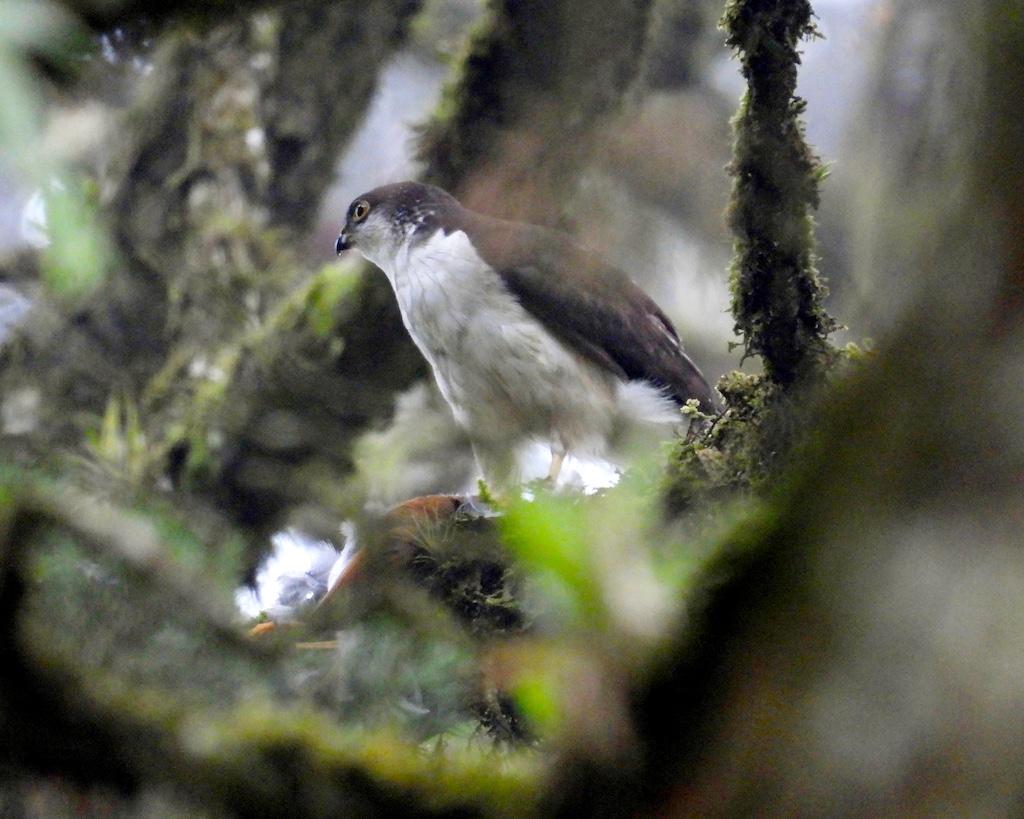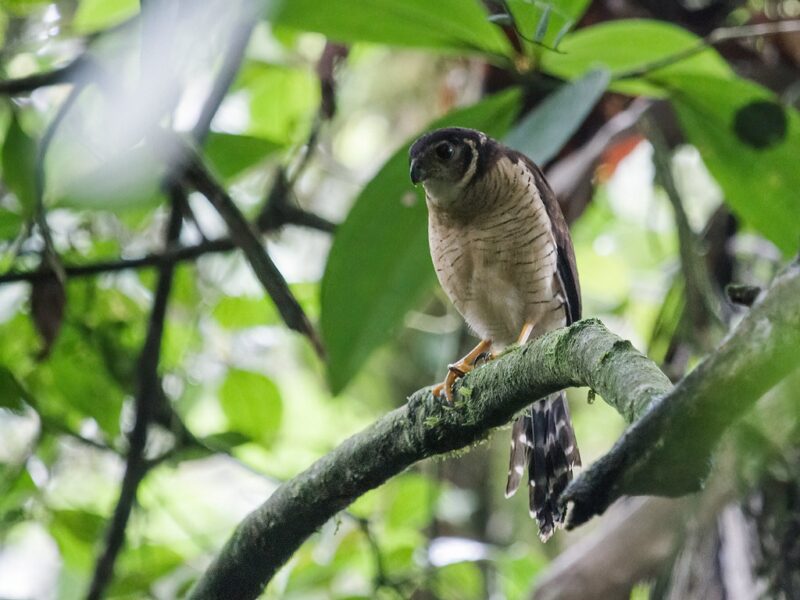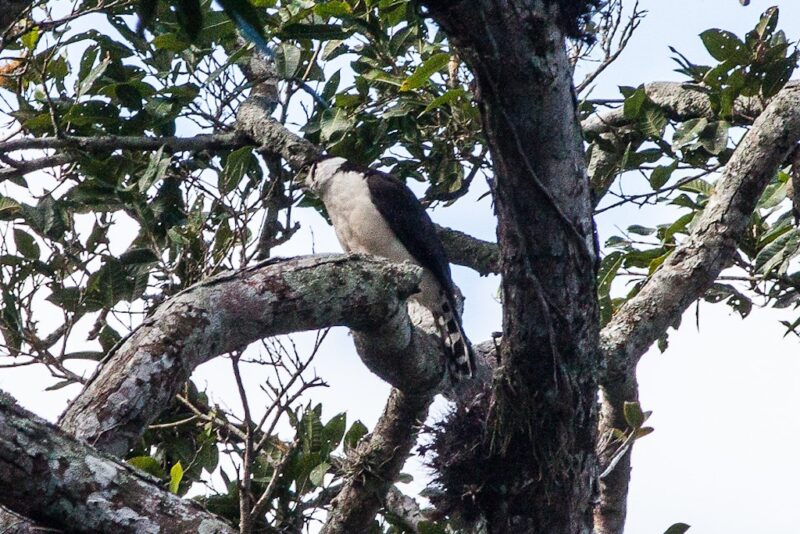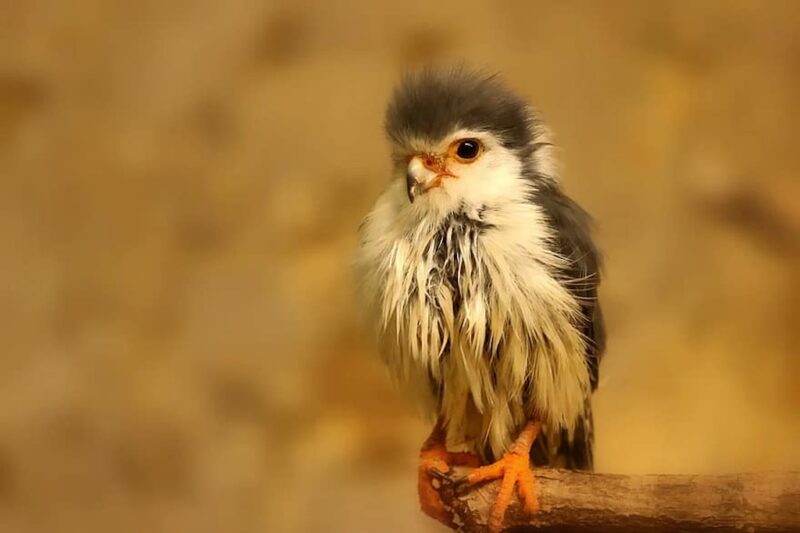Collared forest falcon
Bird of the week

Scientific classification.
Domain: Eukaryota
Kingdom: Animalia
Phylum: Chordata
Clade: Dinosauria
Class: Aves
Order: Falconiformes
Family: Falconidae
Genus: Micrastur
Species: M. semitorquatus
The collared forest falcon (Micrastur semitorquatus) is a bird of prey that belongs to the Falconidae family. It is the most prominent member of the Micrastur genus and is often found in tropical rainforests in Latin America. These birds are very secretive and are usually identified by their distinct call. They are agile and well-suited to their forested habitat, and their diet includes a wide variety of prey ranging from smaller frogs (weighing around 20 g) to adult turkeys (weighing between 2.7-3.2 kg).
The collared forest falcon mainly nests in the cavities of Spanish cedar trees, which are also exploited by the local logging industry. This poses a potential threat to the conservation of the species.

Description
The collared forest falcon is a bird species that has a dark-colored back with a white neck and breast. It has three different variants called morphs: pale, tawny, and dark. The first two variants have a light-colored collar at the back of their neck, which explains their name. This bird is the biggest species of the forest falcon genus, with a total length between 46 and 58 cm (18 and 23 in), a wingspan of 72 to 86 cm (28 to 34 in), and male weights of 467 to 646 g (1.030 to 1.424 lb), with an average weight of 523 g (1.153 lb). On the other hand, female weights range from 649 to 940 g (1.431 to 2.072 lb), averaging 740 g (1.63 lb). Despite its forest lifestyle, this species is related to the Falconidae family, not to hawks. This is because of its rounded short wings, long tail, and lack of the characteristic beak tooth. Although there are some morphological connections to the Falconidae family, such as molt pattern and skull morphology.
M. semitorquatus, also displays sexual size dimorphism, with females being much larger than males in many aspects, including mass, size of beak, tail, and wing chord.
Distribution and habitat
The collared forest falcon is a species commonly found in many Central and South American countries, including Argentina, Belize, Bolivia, Brazil, Colombia, Costa Rica, Ecuador, El Salvador, French Guiana, Guatemala, Guyana, Honduras, Mexico, Nicaragua, Panama, Paraguay, Peru, Suriname, and Venezuela. With a total estimated population between 500,000 and 5 million individuals, they are quite widespread and are year-round residents of their Latin American home.
Thanks to their distinct morphology, the collared forest falcon is able to inhabit a variety of habitats. They can be found in moister regions such as mangroves, tropical and rain forests, gallery forests, and tall second growth. They tend to prefer regions where the undergrowth is relatively dense, allowing them to move and hunt more easily within it. They range from sea level to 2500 m elevation.
Around ten territorial pairs are estimated to occupy a 100 km2 area. However, these estimates are based on radio telemetry of individuals during the breeding season, so they may be different in another context.
Behavior.

Vocalizations
The forest falcon’s call has a distinct low sound, almost similar to a human-like ow or ahr. During the breeding season, these sounds can be heard every morning before sunrise and till mid-morning. Due to the low frequency of the sound, they can be heard from great distances in the dense forest canopy. The falcons’ calls are believed to define their territory, as breeding pairs tend to keep some distance between them.
Both males and females produce an eight-second song, consisting of three or four ow or ahr notes. Sometimes, the females produce a 10-second call with 10-30 more rapid notes preceding the regular call.
The young falcons initially produce a screeching sound, but as they approach fledging and some weeks thereafter, they begin to produce a single-note ahr call.
Diet
The collared forest falcon uses a unique hunting technique, starting with hiding in the dense forest canopy before pursuing prey through flight, or running and hopping along the forest floor. This hunting strategy is supported by their specialized sense of hearing, which is aided by a more pronounced facial disk, similar to owls and harriers. The flexible tail feathers also help when chasing prey in dense forest areas. There are observed differences in hunting techniques among individual M. semitorquatus’.
The Micrastur species has a diverse diet that includes birds, mammals, lizards, snakes, and insects. In a study conducted from 1990-92, researchers counted and identified 223 prey items delivered to the females, nestlings, and fledglings. Of these, 171 were identified, and the largest proportion of the collared forest falcon’s diet consisted of mammals (46.2%), followed by birds (34.5%), reptiles (18.7%), and amphibians (0.6%). Its prey ranged in size from less than 20 g to very large 2.7-3.2 kg.
A comparison with the diet of its relative, the barred forest falcon (Micrastur ruficollis), showed that the collared forest falcon had a mean prey weight that was ten times greater. Since the M. semitorquatus is three times larger than M. ruficollis, it would be more interesting to compare its diet with that of another larger raptor in terms of dietary overlap.

Reproduction
During the dry season from January to March, courtship activities such as vocalizations, searching and guarding of nest sites, prey exchanges, and copulation take place. The egg laying duration extends for 30 days and peaks in March. After that, the female takes on the task of incubating the eggs for about 46-48 days, while the male provides all the food for this period. The young usually fledge after 50 days from hatching and remain dependent on their parents for another 6-11 weeks. It is only later into the nestling period when the mother is able to leave the nest to hunt and the father is no longer the sole provider of food. Additionally, there have been instances where a collared forest falcon has been observed feeding fledglings that are not his own. However, it is not clear why this behavior occurs or how often it is exhibited.
Nests
Collared forest falcons prefer to build their nests inside naturally occurring cavities of large trees and wood debris. These nesting sites are not excavated and occur naturally either through decay or broken limbs. The female birds require a lot of space, so the entrances and nests themselves are quite large. Therefore, larger trees with a diameter at breast height (dbh) of 90 cm to 314 cm are preferred. Among these, Spanish cedar (Cedrela mexicana) is the most favored species. Other trees that have been observed as nesting sites include Honduras mahogany (Swietenia macrophylla), Black Cabbage-bark (Lonchocarpus castilloi), Yellow Mombin (Spondias mombin), and Chicozapote (Manilkara zapota). Nesting in live trees has proven to be more successful than in dead trees, which have mostly been unsuccessful. Breeding pairs tend to use the same nest site for subsequent years.
Egg and clutch size
The collared forest falcon’s eggs are typically dark reddish-brown with tan or dark brown spots. They have small clutch sizes, with an average of two eggs. The eggs’ mass is 53.4 g (+/- 2.6 g).
TOLL FREE
+1 844 385 5958
RESERVATIONS
+506 8862-8873
+506 8862-8873
OFFICE
+506 4600 0800
